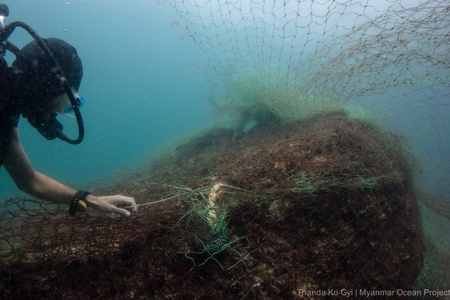I have just returned from a three month Industrial Placement with Myanmar Ocean Project, an NGO focused on addressing the pervasive issue of discarded fishing gear or ‘ghost gear’ across Myanmar. This was part of an industrial fellowship scheme aimed at involving postgraduate researchers in an applied field of research with an industry, or in this case an NGO, in order to gain experience in a relevant field of work.
I joined the team to test how drones and submersible remotely operated vehicles could be used to search for this gear. It was a fantastic opportunity to explore the potential for this technology to address the issue of discarded fishing gear in a part of the world where this is a particular problem. This was my first experience of marine aerial surveying, and I was excited to observe the effectiveness of the technique for underwater exploration.
I flew the drone every morning from the beach and these flights regularly captured not only shoals of fish, but also squads of juvenile eagle rays patrolling the sandbars and, of course the pervasive presence of fishing waste, as tangles of nets were clearly visible close to the shore. I quickly learned that the best conditions for sampling was in the morning, before boat traffic started, the wind was still low, and the sea was clear.
After a quick breakfast on the go, we would dive and survey for nets at multiple sites per day, and I used the ROV to conduct underwater surveys. In almost every dive we found fishing gear, and usually some fish entangled too. This brought home to me how large the scale of the ghost-fishing issue really is, in Myanmar and globally, and how much needs to be done to remove what is there, and prevent new gear from entering the marine ecosystem. We concluded on the basis of this pilot study that a combination of aerial and underwater surveying is optimal for estimating the scale and distribution of ghost gear in tropical waters, and we are in discussion with our partners on further work developing and promoting this method across the world.
This project opened up a great deal for me, and I’m very grateful to Myanmar Ocean Project and Global Ghost Gear Initiative for having me on board, and to Research and Innovation for supporting this research. To learn more about the project, the issue of ghost fishing and work being done by Myanmar Ocean Project, please visit http://www.myanmarocean.org/ Instagram- @MyanmarOcean
To learn more about the issue of ghost fishing, visit https://www.ghostgear.org/


